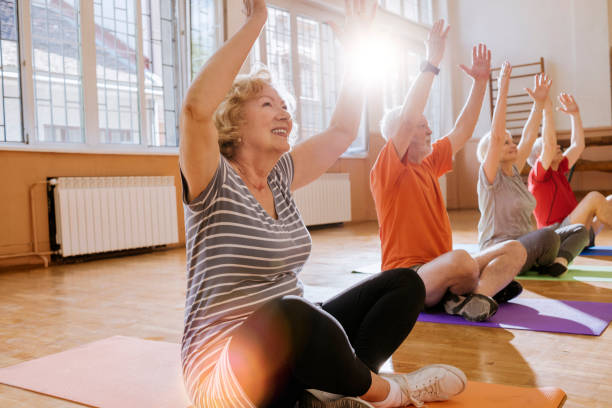Yoga has long been celebrated for its numerous health benefits, from enhancing flexibility to fostering a sense of inner peace. Maintaining physical activity becomes even more crucial as we age, yet traditional yoga poses can sometimes be challenging or daunting for seniors. Adaptive yoga offers a tailored approach, modifying poses to prioritize comfort and safety while still providing all the wonderful benefits of yoga. This blog will explore various aspects of adaptive yoga and how it can be seamlessly integrated into seniors’ lives.
Contents
Understanding Adaptive Yoga
What is Adaptive Yoga?
Adaptive yoga is a personalized approach to traditional yoga designed to meet individual’s unique needs and capabilities, including seniors. By modifying standard poses, incorporating props, and sometimes utilizing chairs for seated poses, adaptive yoga ensures that yoga is accessible and beneficial for everyone, regardless of physical limitations.
Benefits of Adaptive Yoga for Seniors
The advantages of adaptive yoga extend beyond physical wellness. Here are some key benefits:
- Improved Flexibility and Strength: Adaptive yoga helps maintain and enhance muscle flexibility and strength, reducing the risk of injuries.
- Mental Clarity and Relaxation: Practicing yoga promotes mindfulness, reduces stress, and can elevate mood.
- Enhanced Balance and Coordination: Yoga exercises improve balance, which is critical in preventing falls among seniors.
- Social Interaction: Group yoga classes provide a social outlet that can alleviate feelings of loneliness and contribute to overall well-being.
Key Modifications for Seniors
Common Props Used
Props are essential in adaptive yoga, providing the necessary support to ensure poses are performed safely:
- Blocks: Elevate the floor in standing and seated poses to maintain alignment.
- Straps: Aid in achieving a proper stretch without straining.
- Chairs: Offer support for seated poses and balance in standing poses.
- Bolsters and Blankets: Provide cushioning and comfort, reducing joint strain.
Modified Poses
Seated Forward Bend (Paschimottanasana)
- Traditional Pose: Sit with legs extended straight and fold forward.
- Modification: Sit on a chair with your feet flat on the ground. Place a bolster on your thighs and gently fold forward, resting your abdomen and chest on the bolster.
Supported Warrior I (Virabhadrasana I)
- Traditional Pose: Lunge forward with one leg, arms raised overhead.
- Modification: Stand with feet hip-width apart and place hands on the back of a chair for support. Step one foot back, keep the front knee bent, and raise one arm overhead, using the chair for balance.
Creating a Safe Yoga Environment
Setting Up Your Space
A safe practice environment is essential to prevent injuries and create a calm, relaxing atmosphere:
- Clear the Area: Remove any tripping hazards such as loose rugs or clutter.
- Use Non-Slip Mats: Ensure your yoga mat is non-slip and placed on a stable surface.
- Adequate Lighting: Ensure the space is well-lit to avoid any accidental falls or injuries.
Warm-Up and Cool Down
Warming up before and cooling down after each session is critical for preventing injuries and promoting muscle recovery:
- Warm-Up: Start with gentle movements like neck stretches, shoulder rolls, and light walking to get the blood flowing.
- Cool Down: Conclude with deep breathing exercises and relaxation poses such as Child’s Pose or Legs-Up-the-Wall to ease the body into a state of rest.
Tailoring Adaptive Yoga to Individual Needs
Assessing Fitness Levels
Before starting an adaptive yoga practice, it’s important to gauge the fitness level and specific needs of the senior:
- Consult with a Medical Professional: Obtain clearance from a healthcare provider, especially if there are chronic conditions or concerns.
- Evaluate Mobility: Assess current flexibility, strength, and balance to tailor the yoga session accordingly.
Customizing the Practice
Individualizing the practice ensures it meets each person’s unique needs:
- Pose Selection: Choose poses that target areas needing improvement, such as flexibility, balance, or strength.
- Duration: Adjust session length based on endurance and comfort levels.
- Pace: Maintain a gentle and slow pace to allow for proper alignment and prevent overexertion.
Integrating Adaptive Yoga into Daily Routine
Establishing a Routine
Consistency is key to reaping the benefits of adaptive yoga:
- Set a Schedule: Create a routine by choosing specific days and times for yoga practice.
- Stay Committed: Encourage regular practice, even if sessions are short.
Combining Yoga with Other Activities
Adaptive yoga can complement other forms of exercise and daily activities:
- Walking: Combine yoga with a daily walk for cardiovascular benefits.
- Strength Training: Use yoga to enhance muscle recovery after strength training.
- Mindfulness Practices: Integrate meditation or breathing exercises for a holistic approach to wellness.
Conclusion
Adaptive yoga holds the promise of making yoga accessible, enjoyable, and beneficial for seniors. By modifying traditional poses and creating a supportive environment, seniors can safely engage in yoga, reaping its multitude of physical, mental, and emotional benefits. Whether seeking to improve flexibility, enhance balance, or find a moment of peace, adaptive yoga offers a path to wellness that accommodates the diverse needs of aging individuals. So, roll out your yoga mat, gather your props, and discover the joy and tranquility that adaptive yoga can bring to your life.
